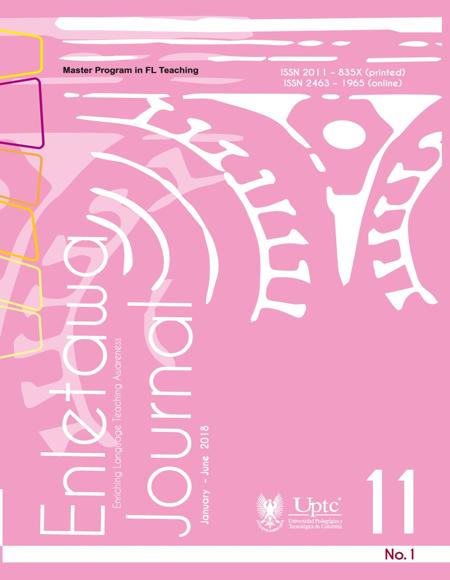Using feelings and emotions in the EFL classroom to improve writing skills through story writing workshops

Abstract
This paper aims at analyzing the role that feelings and emotions play when they are utilized inside the EFL classroom with eighth grade students. They were encouraged to talk about their feelings and emotions through the development of ten workshops based on writing short stories from their own life experiences. The results showed that feelings and emotions are a part of students that cannot be ignored because they are a factor in the learning process. Self-directed learning and a positive classroom environment are also key factors that should be considered in addition to the students’ emotional side when learning English as a foreign language.
Keywords
Feelings, Emotions, Short stories, Writing skills
References
Bowman, M. (1994). Using video in research. Spotlights, 45. Scottish Council for Research in Education. Retrieved from: http://www.sfu.ca/media-lab/ cmns362/Spotlight45.pdf
Broks, P. (2003). Into the silent land. London: Atlantic.
Calle, M., De Cleves, N., and Velázquez, B. (2011). NOVA: Publicación Científica en Ciencias Biomédicas. Incidencia de la Inteligencia Emocional en el Proceso de Aprendizaje. Retrieved from: http://www.unicolmayor.edu.co/invest_nova/NOVA/ NOVA15_REVIS2_INTELIG.pdf
Carr, W., and Kemmis, S. (1986). Becoming critical: Education, knowledge and action research. Lewes: Falmer.
Cherry, K. (2014, October). About. Com Psychol. Overview of the 6 Major Theories of Emotionogy. Theories of Emotion. Retrieved from: http://psychology.about. com/od/psychologytopics/a/ theories-of-emotion.htm
Coe, N., and Rycroft, R. (1983). Writing skills. A problem-solving approach. Teacher´s book. United Kingdom: Cambridge University Press.
Cuesta, L., and Rincón, S. (2010). Short story student-writers: Active roles in writing through the use of e-portfolio dossier. Colombian Applied Linguistic Journal, 12, 99-115.
Damasio, A. (1994). Descartes´ error: Emotion, reason and the human brain. New York: Putman.
Damsio, A. (2000). The feeling of what happens: Body, emotion and the making of consciousness. London: Vintage.
Damasio, A. (2004). Emotions and feelings: The Amsterdam Symposium. Neurobiological perspective: Studies and emotions and Social Interaction: Feelings and Emotions. United Kingdom: Cambridge University Press.
Dörnyei, Z. (2007). Creating a motivating classroom environment. In J. Cummins & C. Davison (Eds.), International handbook of English language teaching (pp. 719-731). New York, NY: Springer.
Fink, A. (2003). The survey handbook (2nd Ed.). United States of America: Sage Publications, Inc.
Hiemstra, R. (1994). Self-directed learning. In W. Rothwell & K. Sensenig (1999). The sourcebook for self- directed learning. Amsherst, Massachusets: HRD, Press.
Lodico, M., Spaulding, D., & Voegtle, K. (2010). Methods in educational research (2nd Ed.). San Francisco: Jossey Bass: A Wiley Imprint.
Lucke, M. (1999). Schaum’s quick guide to writing great short stories. U.S.A: McGraw Hill Companies. Retrieved from: http://books.google. com.co/books?id=qoYNPolwZC&printsc=frontcover&source=gbs_v2_summary_r&cad=0#v=onepage&q=&f=false
MacIntyre, P. (2002). Motivation, anxiety and emotion in second language acquisition. In P. Robinson (Ed.), Individual differences and instructed language learning (pp. 45-68). Amsterdam, nl: John Benjamins Publishing.
Marshall, C., and Rossman, G. (1989). Designing qualitative research. Newbury Park, CA: Sage.
Meyer, D. K., and Turner, J. C. (2006). Re-conceptualizing emotion and motivation to learn in classroom contexts. Educational Psychology Review, 18(14), 377-390.
Ministerio de Educación Nacional. (2012). Competencias Ciudadanas. Retrieved from: http://www. mineducacion.gov.co/1621/w3article-235147.html
Mubarak, M. (2013). The use of shortstories in EFL classroom: Advantages and implications. Labyrinth, An International Refereed Journal of Postmodern Studies (4), 2, 21-26.
Newmann, F. M. (1992). Student engagement and achievement in American secondary schools. New York, USA: Teachers College Press.
Osterholm, K. (1986). Listening, reading and writing analysis and application. Writing in the native language. B. H.Wing (Ed.). Middlebury, VT: Northeast Conference, l7 -43.
Patton, M. (1985). Quality in qualitative research: Methodological principles and recent developments. Paper presented at the American Educational Research Association, Chicago: IL.
Perry, B. (n.d). Creating and Emotionally Safe Classroom. Early Childhood Magazine Scholastic. Retrieved from: http://teacher.scholastic. com/professional/bruceperry/ safety_wonder.htm
Powers, W.T. (1992). Living control systems II. New Canaan, Connecticut: Benchmark Publications.
Punch, K.F. (1998). Introduction to social research: Quantitative and qualitative approaches. Thousand Oaks: Sage.
Reigeluth, C. (1999). Instructional design theories and models. NJ: Lawrence Erlbaum Associates, Inc.
Simonsen, B. (2007). Emotions and Feelings. A comparative presentation of Emotions and Feelings expressed by Antonio Damasio and expressed by William T. Powers in his Perceptual Control Theory. Retrieved from: http://www. psych-sci.manchester.ac.uk/ aboutus/events/csgconference/ proceedings.pdf#page=29
Strauss, A., and Corbin, J. (1997). Grounded theory in practice. United States: Sage Publications.
Sylwester, R. (1994). How emotions affect learning. Educational Leadership 52, (2), 60-65.
Yin, R. (1984). Case study research: Design and methods. Newbury Park, CA: Sage.